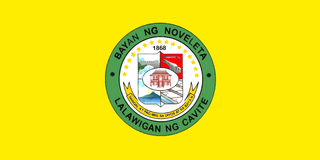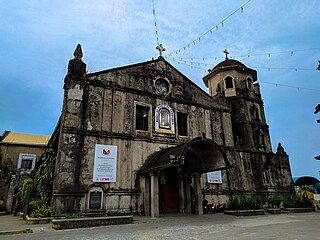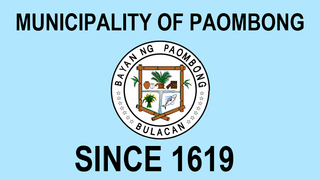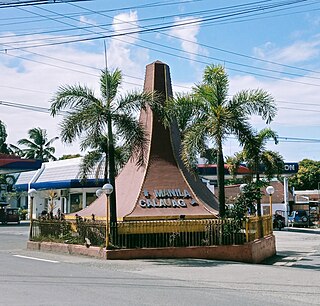This article needs additional citations for verification .(December 2014) |
Tanza Santa Cruz de Malabon | |
|---|---|
| Municipality of Tanza | |
 Aerial view of Tanza | |
| Nickname: Heart of the Cavite Coast | |
| Motto(s): | |
| Anthem: Filipino: Tanza, Bayang Makasaysayan English: (Tanza, Historic Town) | |
 Map of Cavite with Tanza highlighted | |
Location within the Philippines | |
| Coordinates: 14°23′40″N120°51′11″E / 14.39444°N 120.85306°E | |
| Country | Philippines |
| Region | Calabarzon |
| Province | Cavite |
| District | 7th district |
| Founded | 1760 |
| Annexation to San Francisco de Malabon | October 15, 1903 |
| Chartered | 1910 |
| Renamed | February 28, 1914 (as Tanza) |
| Barangays | 41 (see Barangays) |
| Government | |
| • Type | Councilors |
| • Mayor | Yuri A. Pacumio |
| • Vice Mayor | Archangelo B. Matro |
| • Representative | Crispin Diego D. Remulla |
| • Municipal Council | Members |
| Area | |
• Total | 78.33 km2 (30.24 sq mi) |
| Elevation | 57 m (187 ft) |
| Highest elevation | 642 m (2,106 ft) |
| Lowest elevation | 0 m (0 ft) |
| Population (2020 census) [3] | |
• Total | 312,116 |
| • Density | 4,000/km2 (10,000/sq mi) |
| • Households | 79,243 |
| Demonym(s) | Tanzeño (masculine or neutral) Tanzeña (feminine) |
| Economy | |
| • Income class | 1st municipal income class |
| • Poverty incidence | 11.85 |
| • Revenue | ₱ 1,147 million (2022) |
| • Assets | ₱ 1,781 million (2022) |
| • Expenditure | ₱ 887.2 million (2022) |
| • Liabilities | ₱ 583.2 million (2022) |
| Service provider | |
| • Electricity | Manila Electric Company (Meralco) |
| • Water | Tanza Water District |
| Time zone | UTC+8 (PST) |
| ZIP code | 4108 |
| PSGC | |
| IDD : area code | +63 (0)46 |
| Native languages | Tagalog |
| Major religions | |
| Feast date |
|
| Catholic diocese | Diocese of Imus |
| Patron saint | |
| Website | www |
Tanza, officially the Municipality of Tanza (Tagalog : Bayan ng Tanza), formerly known as Santa Cruz de Malabon, is a 1st class urban municipality in the province of Cavite, Philippines. According to the 2020 census, it has a population of 312,116 people. [3] It has a land area of 95.59 square kilometers (36.91 sq mi), making it the third largest municipality by land area in the province.
Contents
- History
- Cityhood
- Geography
- Barangays
- Climate
- Demographics
- Religion
- Languages
- Economy
- Poverty incidence
- Retail and business process outsourcing
- Municipal income
- Government
- Elected officials
- List of former municipal heads
- Education
- Day care centers
- Elementary schools
- High schools
- Colleges
- Notable personalities
- See also
- References
- External links
Tanza was awarded the "Seal of Good Financial Housekeeping" in 2011, 2012, 2018, 2019, and 2021 and the "Seal of Good Local Governance" in 2016 by the Department of the Interior and Local Government. The municipality was named 2014 most competitive in economic dynamism by the National Competitiveness Council, eighth most populous municipality (2015 NSO Census), and 15th largest Municipality Revenue Earner based on the 2016 Bureau of Local Government Finance Financial Report.[ citation needed ]
Tanza is the place where Emilio Aguinaldo was sworn in as the president of the revolutionary government of the Philippines, in front of the ancient Santa Cruz or Holy Cross (the titular of Tanza's main Catholic parish). Other officials elected at Tejeros Convention elections, including Mariano Trias as vice president, also took their oath with Aguinaldo. Also, Tanza was the birthplace of Felipe G. Calderon, the person who drafted the Malolos Constitution.
Tanza is the home of Cavite Gateway Terminal, the first roll-on, roll-off barge terminal in the Philippines. [5]
































